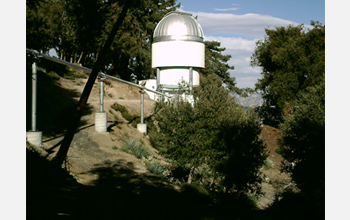Multimedia Gallery
A telescope making up part of the CHARA Array is shown on Mount Wilson, Calif., in November 2009.
A telescope making up part of the CHARA Array, a six-telescope optical/infrared interferometric array, is shown on Mount Wilson, Calif. The CHARA Array is among the most powerful facilities of its kind in the world for studying stars and stellar systems at resolutions not previously available. Built with funds from the National Science Foundation, Georgia State University, the W. M. Keck Foundation, and the David and Lucile Packard Foundation, ground was broken in 1996 at historic Mount Wilson Observatory. The facility was dedicated in 2000, and "first fringes," which demonstrated the technical feasibilty of CHARA's design, were obtained in 2001. Another three years of installation was required before the array became fully operational in 2004; routine, scheduled observing began in the spring of 2005. Collaborative teams have joined with Georgia State University scientists to extend the science capabilities of the array through "beam combination" instruments that provide for increased wavelength, spectral and polorimetric coverage.
Credit: Robert Stencel, University of Denver
Images credited to the National Science Foundation, a federal agency, are in the public domain. The images were created by employees of the United States Government as part of their official duties or prepared by contractors as "works for hire" for NSF. You may freely use NSF-credited images and, at your discretion, credit NSF with a "Courtesy: National Science Foundation" notation.
Additional information about general usage can be found in Conditions.
Also Available:
Download the high-resolution JPG version of the image. (361 KB)
Use your mouse to right-click (Mac users may need to Ctrl-click) the link above and choose the option that will save the file or target to your computer.
Related story: Astronomers Capture a Rare Stellar Eclipse in Opening Scene of Year-long Show



